54 Large intestinal obstruction
Etiology
Similar to the small intestine, the large intestine can be functionally or physically obstructed. When the large intestine is obstructed, gas and feed material are backed up. Obstruction leads to decreased fecal output, abdominal distension and discomfort. Gas buildup indicates a complete obstruction (this can be physical or functional obstruction). Mild dehydration can occur along with mild pain signs.
Ileus
Functional obstruction is due to dysfunction of nerves and/or muscles. Functional obstruction is termed “ileus” and can lead to a backup of feces, gas or a combination of feces and gas. Causes include increased sympathetic tone, decreased motility (due to decreased exercise, drugs, neuronal changes in the enteric or autonomic nervous system), and surgery/anesthesia.
Physical obstruction
Physical obstruction can be luminal or extraluminal. Luminal obstructions are usually due to dried out feces, but can be enteroliths, foreign objects, hair balls, neoplasia etc. Extraluminal obstruction can occur due to twists or displacements (kinks), tumors, or adhesions (scar tissue from previous surgery or inflammation).
Obstruction in the hindgut leads to impacted dry feces and to gas buildup proximal to the obstruction. Animals may become so gassy that they appear distended. When the obstruction is passed, the manure may be dry and mucous covered due to its longer time in the colon.
Examples
In horses, feed impactions are very common. These usually occur at the pelvic flexure – part of the large colon that makes a hairpin turn and narrows. Feed impactions occur due to poor mastication, poorly digestible feedstuffs, decreased water intake, decreased exercise, changes in routine and recent illness, among lots of other things. If the total body water content becomes too low (dehydration), more water is absorbed from the colon, making the stool even drier. Stool that is retained in the colon will also become dry. Astute animal owners can detect changes in their pet through changes in the stool size and consistency.
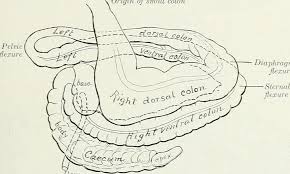
Displacements are another common cause of obstructions – the bowel moves around and kinks off. Again, this is a common problem in horses since their guts are full of gas producing bacteria and are not tacked down. See video animation
Horses frequently get “gas colic” with tremendous buildup of gas in the large intestine but without any physical obstruction. The gas distension may start with an excess of fermentable foods; happy microbes produce more gas. More gas stretches the colon wall and sets up a pain response which increases sympathetic tone and makes things worse.
Horses can also get postoperative ileus, generally associated with small intestinal surgery.
Generally in small animals, constipation is due to physical obstruction (pelvic fracture, foreign body), functional obstruction (dysmotility due to chronic obstruction, nerve degeneration, metabolic diseases), or neoplasia.
Foreign bodies usually get stuck more proximally (stomach and SI) but can work their way down if smaller objects. Small animals don’t get as gassy unless suffering chronic complete obstructions.
Primary constipation is relatively rare in dogs. Cats get megacolon – severe impactions that just sit there. These are considered due to neuronal dysfunction. Chronic constipation may also result in secondary dilation and dysfunction of the colon.
Cattle tend to develop functional obstructions after calving due to low calcium levels (all of the calcium is going into milk production). This leads to ileus and often cecal dilation.
Diagnostics
Diagnostics depend a bit on the size of the animal. In all cases, abdominal contour can be useful as can the level of pain (generally mild) and dehydration (mild). In fermenters such as cattle and horses, functional or mechanical obstruction usually results in bloat (abdominal distension). Unless an intestinal twist is causing the obstruction, these animals are not usually as sick as those with upper GI obstructions.
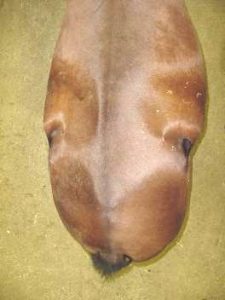
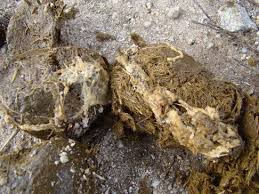
Small animals – Clinical signs include abdominal distension and mild pain. Stool may be dry. Vomiting is usually not observed. Dehydration may be evident but is usually mild. Diagnostics focus on abdominal palpation and radiographs. On radiographs, colonic distension with feed material is observed. The colon can be identified by its extension into the pelvis. Additional diagnostic evaluation may include digital rectal examinations, other imaging, and laboratory workup to identify inflammatory, metabolic or endocrine disorders.
Large animals – Clinical signs include abdominal distension, changes on rectal palpation, mild pain, mild dehydration and fecal balls that are small and dry. Feces that have been held in the colon for longer than usual may be coated with mucus. Reflux is not usually observed. Response to therapy is also useful as a diagnostic test. We know most cases of equine colic are gas (functional obstruction) and pelvic flexure impactions (feed impactions) so often treat for those and only explore additional diagnostics if the animal does not respond.
Most animals with complete obstruction develop bilateral abdominal distension. Due to the large rumen, cattle can have unilateral distension and we use the location to help identify what is likely distended.
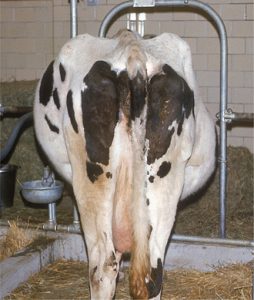
Upper GI vs Lower GI
| Upper GI | Lower GI | |
| Reflux/vomiting | often | not common |
| Abdominal contour | normal | bloated |
| Feces | scant | dry, small |
| Dehydration | moderate to severe dehydration | normal to slight dehydration |
| Electrolyte issues | low chloride, acid-base issues | normal |
Therapy
Animals that are not defecating frequently enough may be treated conservatively at home, medically in the clinic or with surgery. Being able to localize the lesion to the small or large intestine will enhance decision making, as animals with small intestinal obstruction will tend to be sicker and less likely to respond to at home treatment. This is related to the large volume of secretions and electrolyte movement in that section.
For mild impactions, overhydration via enteral fluids (through the GI tract, not intravenously), exercise, analgesics and laxatives are often enough to get things moving.
Buscopan is used in horses for gas colic. This drug actually slows motility (anticholinergic) but that can help with gut spasms. Removing the gut spasm decreases pain and decreases the flight response, leading to an eventual improvement in gut activity. Repeated doses would be bad though – leading to primarily decreased gut function.
Gastric distension can be used to stimulate the gastrocolic reflex and empty the colon.
Laxatives are frequently given to cats and horses to help dry feed material and hairballs slide through. Various types of laxatives can be used. Insoluble fiber is useful in all species to help peristalsis and maintain good fecal water levels.
| Lubricants | Softeners | Bulk formers | Stimulants |
| Mineral oil | Epsom salt | Wheat bran | Bisacodyl |
| Metamucil | DSS |
Key Takeaways
- Obstruction of the LI leads to decreased fecal output, desiccated feces, and bloat
- SI and LI obstruction can be differentiated based on vomiting vs bloat and fluid/electrolyte losses vs minimal blood changes
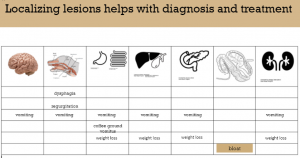
Resources
Constipation – video -management in humans (similar)
The horses hindgut and common digestive problems – video
Impaction colic in horses – web article
Megacolon in cats – web article
Milk fever in cattle – web article
Bowel obstruction, causes and pathophysiology– really nice overview; yes human but it all is relevant
Equine obstructions– straight forward overview of obstructions and torsions (and cool animations)
Treating mild equine colic -short and sweet, horse owner perspective but also includes neuroanatomy
The equine digestive system- a food factory – an early look at digestion with a motility lens
Digestive track comparison – comparative function and adaptations in one page
Nephrosplenic entrapment animation – you will get security warnings but it seems safe
Advanced Physiology
Comparison mammalian GI tracts– slide show, includes exotics
Constipation and diarrhea – water movement and peristalsis – deeper look at osmosis and water regulation
Small bowel obstruction – in people and includes complications
Normal radiographic anatomy of the canine abdomen
Just for fun
Small bowel ischemia and infarcts – for those of you that like equine colic topics
Irritable bowel syndrome – probably in our vet patients too
Hirschprungs disease – compare to lethal white foals and congenital aganglionosis in SA patients
Ultrasound of a horse with right dorsal displacement– mostly still shots but some live footage too
Coastal hay colic in horses – if you are going to work in the SE USA
Colic in broodmares – more cool animations
Constipation and constipation management – human diets

